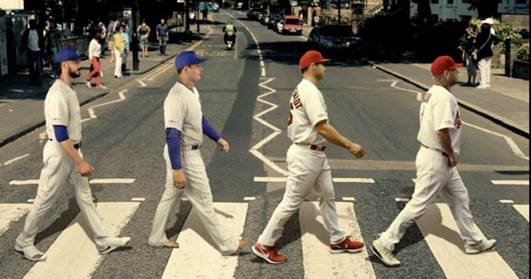Rita and I will soon head to Naples, Florida, for some R&R. Hot Stove will also take some R&R, probably for the rest of November – Hot Stove readers deserve a break.
Warning: When you get to Lonnie’s Jukebox, you will see that it is long. You may want to save it for another day (especially if you are going to listen to the songs).
2019 World Series – Drought Be Gone: I got my wish. The Washington Nationals (nee Montreal Expos from 1969-2004) won their first World Series in franchise history, ending a 50-year drought. They beat the Houston Astros who did a similar thing in 2017, winning their first World Series and ending a 55-year drought. The franchises that still have not won a World Series (and their date of origin): Texas (1961), Milwaukee (1969), San Diego (1969), Seattle (1977), Colorado (1993) and Tampa Bay (1998). Among non-expansion franchises, the longest current drought belongs to the Cleveland Indians. They last won in 1948.
The Beginning – Houston Has Problems: Houston kicked off the Series with three bad days at Minute Maid Park. The first was the locker room celebration after their win over the Yankees in the ALCS. Astros official Brandon Taubman made sneering comments to women reporters in the locker room, apparently in response to unfavorable news coverage about the Astros signing pitcher Roberto Osuna who had been suspended for domestic abuse. One of the reporters wrote about Taubman’s remarks in Sports Illustrated. The team responded defensively, saying the SI story was fabricated. After reporters from other papers backed up the SI report, the team continued its tone-deaf attitude for a while, but finally fired Taubman and gave an actual apology.

The next two bad days at home came with Games 1 and 2. Each featured pitching royalty. Game 1: Max Scherzer (Nats) v. Gerrit Cole (Astros). Cole was not sharp and lost 5-4. Game 2: Stephen Strasburg (Nats) v. Justin Verlander (Astros). Strasburg was good. Five Astros pitchers were not. Washington won big, 12-4. The Nats headed back to DC with visions of a sweep.
The Middle – Nats Have No Bats: Nationals Stadium was filled with joyous fans and baby sharks. But not with hits by the home team. The Astros won Games 3, 4 and 5 with a combined score of 19-3. It was the Astros turn to have visions of winning four in a row.
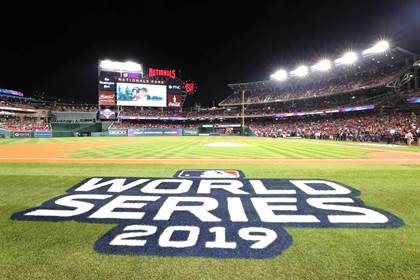
A big disappointment for Washington was that ace Max Scherzer had a sore neck and was not able to pitch Game 5. The big question: Would cortisone and rest make him available for a potential Game 7?
The End – Home Not Sweet Home: In the first five games, the visiting team won. Game 6 and, if necessary, Game 7 were in Houston. Surely the Astros were now in a winning mode after dominating the Nats in DC. Well, not so.
Game 6: This game was a pitching rematch of Game 2. Verlander went 5 innings and allowed three runs. Strasburg pitched superbly, allowing two runs and pitching into the 9th inning. Reliever Sean Doolittle came in to get the final two outs. The Nats won 7-2.
[9th Inning Trivia: The last starter before Strasburg to pitch into the 9th inning of a Series game was Matt Harvey of the Mets. It was Game 5 in 2015, and the Mets led the Royals 2-0 after eight innings. Harvey begged manager Terry Collins to leave him in to complete the game. Harvey gave up two runs in the 9th, tying the game, and the Royals won 7-2 in the 12th to win the Series. The 2015 Series is also the last one to have a complete game by a pitcher – the Royals Johnny Cueto in Game 2.]
Strasburg was great, but Game 6 will be most remembered for a bizarre top of the 7th inning. The Nats were ahead 3-2 and threatening to blow the game open with men on second and third and nobody out. And then without another play, there was one out and a man on first. This was because of The Interference Call (to be more fully discussed below).
Game 7: Everybody loves 7th games.
| MLB Jesus (@MLBJesus) | |
| 10/30/19, 7:13 PM
“And on the 7th day, He rested and watched baseball.” -Genesis 2:2 |
|
Max Scherzer certainly wanted a 7th game. After being unable to pitch in Game 5, he needed his Nats to win Game 6 and also recover from his cortisone shot for his neck. He was cleared for the game, setting the stage for a matchup against Zack Greinke (winner of a Cy Young Award back in 2009 when he was with the Royals).
[Scherzer Trivia: Max Scherzer played two years for Missouri University at Columbia before being drafted by Arizona in 2006. He famously has a blue right eye and a brown left eye.]

Greinke pitched a shutout for six innings. In the 7th, after one out, he gave up a homer to Anthony Rendon, reducing the Astros lead to 2-1. Then a walk. Manager A. J. Hinch decided to pull Greinke (maybe too early?) who had only thrown 80 pitches. Many thought Hinch would bring in his ace starter Gerrit Cole who had warmed up in the bullpen. Hinch instead went with five other pitchers over the remaining 2.2 innings. It did not go well. The Nationals scored two more runs in the 7th, one in the 8th and two in the 9th.
Scherzer struggled and was lucky to allow only two runs before he left after the fifth inning (allowing 11 men to reach base; 103 pitches). Manager Dave Martinez took a different approach than Houston’s Hinch. He elected to bring in a starting pitcher, Patrick Corbin, who pitched three shutout innings. For the 9th, Hinch went to his closer Daniel Hudson who finished off the Astros with a 1-2-3 inning. This was a sweet finish for Hudson who had missed Game 1 of the NLCS to be with his wife when his daughter was born.
The home-field disadvantage applied for the seventh straight game. The final score was 6-2. The Washington Nationals were World Champions.
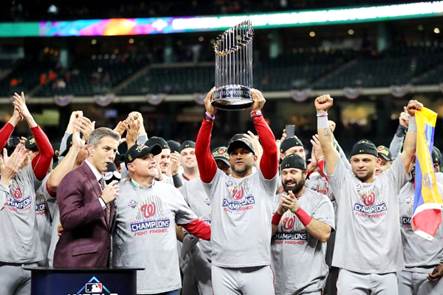
The MVP award went to Stephen Strasburg for his two wins in the Series. He was 5-0 in the playoffs. There were also some batting stars that likely picked up some MVP votes – Anthony Rendon, Juan Soto and Howie Kendrick.
The Interference Call: In the top of the 7th in Game 6, there was a rare ruling of runner interference. When I saw this called on the Nats Trea Turner, my first thought was of a similar situation from the World Series of 50 years ago. Not that I would remember the play from then, but I had just read about it while working on the recent Hot Stove about the Miracle Mets. George Vecsey told the story in his book (Joy in Mudville) and included a photo that I remembered. Here it is:

The photo is from Game 4 of the 1969 Series, Mets v. Orioles. The Mets had men on first and second in the bottom of the 10th, no outs, score tied 1-1. Pinch hitter J. C. Martin laid down a bunt to move the runners over. Orioles pitcher Pete Richert fielded the bunt and threw to first, but he hit Martin in the wrist and the ball ricocheted toward second base. Pinch runner Rod Gaspar had been on second and was running on the bunt, so it was easy to round third and score the winning run. The Mets went on to win the Series the next day in Game 5.
As can be seen in the photo, Martin is some distance from first base as the ball is about to hit him. He was not in the running lane (between the two parallel white lines) and so was subject to a call of interference if he got in the way of a throw. He could have been called out and the other runners would have to return to first and second. But the umpires did not make the interference call.
Almost everyone agrees in hindsight (with the benefit of photos like this and video) that there was interference. That was no help to the Orioles whose objections got lost when the Mets fans swarmed the field. Orioles manager Earl Weaver was not shy about arguing with umpires, but he was not around in the 10th inning – he had already been thrown out of the game in the 3rd for arguing balls and strikes.
Fast forward to Game 5 in 2019. With one man on and no outs in the 7th, the Nats Trea Turner hit a dribbler to the pitcher. In a very close play at first, the ball hit Turner and caromed into foul territory. The runners ended up at second and third. Home plate umpire Sam Holbrook called Turner out for interfering with the throw, and the other runner had to return to first. It was a potential game (and Series) changer. If the umpire was right, so be it. If he was wrong, he could be the next Don Denkinger.
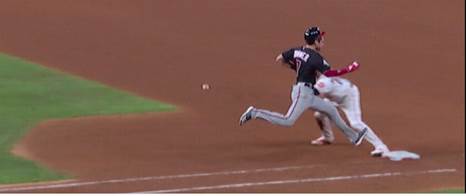
The Nationals bench exploded with anger. Twitter went wild.
| MLB Jesus (@MLBJesus) | |
| 10/29/19, 9:43 PM
That call was a sin. |
|
The umpires checked with the New York replay folks, not on the play itself, but on the details of the rule. A runner has the right to interfere if he is in his last stride to the base (as was the case as seen in the photo above); BUT, BUT, the last stride exception does not apply if the runner was not first in the running lane on the foul side of the first base line. Turner had not done that. So he was out. Or maybe Turner reached first before he was hit with the ball – then the rule might not apply. Whatever, the play was not reviewable – it’s a judgment call. If you really want to dig in, my law partner Tim Sear sent me this analysis with videos (click here).
Manager Ejection: After the interference call, the next batter popped up to make it two outs. Then Anthony Rendon hit a 2-run homer to make it 5-2. That took some of the pressure off of the interference call, but manager David Martinez was still not satisfied. After the inning was finished, he renewed his argument and was ejected. Most of this was not seen on TV because of commercials, but there are clips that not only show the argument, but provide background music – “Take Me Out to the Ballgame” was being played for the 7th inning stretch. It’s pretty funny. Click here.
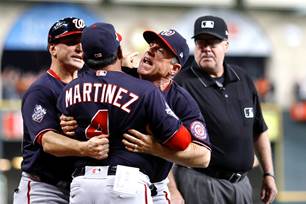
The ejection of a manager in the World Series is almost as rare as an interference call. Only six in the last 50 years. Before Martinez, the prior two were for Bobby Cox in 1992 and 1996. Cox holds the record for career ejections during the regular season (161). Cardinals manager Whitey Herzog was ejected in Game 7 in 1985. I was at that game – Whitey was still no doubt mad about the Denkinger call in Game 6. Billy Martin in 1976 (no surprise). Earl Weaver in Game 4 of 1969, for balls and strikes, not the non-call of interference in that game as discussed above.
Tom Boswell: One of the cool things about this Series was getting to read so many columns by Tom Boswell. Now 72, Boswell has been with the Washington Post his entire career. His graceful writing and astute observations put him in the company of Red Smith and Roger Angell. A good hint comes from the titles of two of his books: How Life Imitates the World Series and Why Time Begins on Opening Day. On the last night of the Series, Dan Shaughnessy of the Boston Globe tweeted this photo of Boswell working on his Game 7 column (to read it, click here).
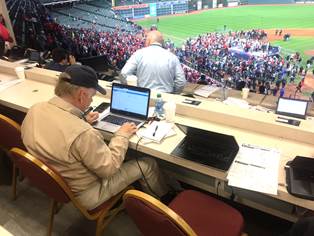
The Decade the Yankees Lost the Pennants (2010-2019): Damn Yankees was based on the book The Year the Yankees Lost the Pennant. In the book (and the movie and musical), the devil helps the Washington Senators win a pennant race over the Yankees (circa 1950). Those Senators were in the American League. The current Washington team is in the National League, and so the Nationals, with or without help from the devil, cannot block the Yankees from the AL pennant. They must rely on the American League teams to do that. For this past decade, that has worked out just fine.
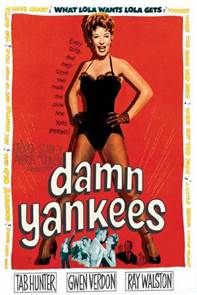
In their first two decades of existence, the Yankees did not win a pennant (1901-1919). Then they got Babe Ruth. They won six pennants in the 1920s to start a string of ninety years during which they won a least one pennant each decade (the cumulative total – 40 pennants). Then came the 2010s – NO PENNANT. From 2010 to 2019, the Yankees were in the postseason seven times, but never won a pennant. Texas and the Red Sox eliminated them one time each and Detroit did it twice. The Astros stopped the Yankees three times: in the Wild Card in 2015 and the ALCS in 2017 and 2019. Take that Damn Yankees!
Hot Stove Season Begins: With the postseason over, we move to the “hot stove league.” The term is said to date from the 19th century when, during the winter, people “gathered at the general store/post office, sat around an iron pot-bellied stove, and discussed the passing parade. Baseball, along with weather, politics, the police blotter and the churches, belonged in that company.” That was the original idea of my Hot Stove missives after the Royals won the 2015 World Series. But then I got the bug and posted beyond the hot stove season. The iron hot stove is long gone, replaced with endless discussions on social media and the internet. And this Hot Stove you are reading.
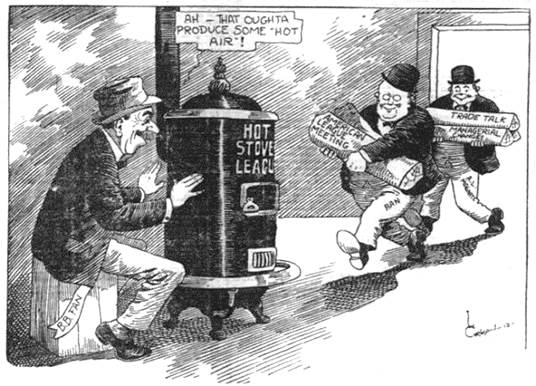
Royals fans will have plenty to talk about over the winter. One of the subjects on the logs in the old (1913) cartoon above – Managerial Changes – will be of special note. The controversial hiring of Mike Matheny as the new manager is generating a lot of press. I have already heard from two Hot Stove readers/Cardinals fans who were bluntly negative. Welcome to the Royals Mr. Sherman (John Sherman is expected to close on his purchase of the Royals this month). Salvy will be back for 2020. Alex Gordon is a free agent. Lots of potential in the minor league pitchers – how many years before they are ready? Former Royal Carlos Beltran was just named the manager for the Mets. Why did the Kansas City Star virtually ignore the World Series? And so on.
Hot Stove Season Ends: Royals pitchers and catchers report to Surprise, Arizona, on February 12, 2020. Position players on February 17. First spring training game on February 23. Opening Day in Chicago against the White Sox on March 26 (sounds cold) and in KC against Seattle on April 2 (also probably cold).
| MLB Jesus (@MLBJesus) | |
| 10/31/19, 8:28 AM
Let there be only 103 days of darkness until Pitchers & Catchers report. 🙌 |
|
Lonnie’s Jukebox – Abbey Road – 1969: Fifty years ago this month, the Beatles hit #1 on the pop charts with a two-sided hit: “Something” and “Come Together.” Both songs were cuts from the Abbey Road album that was released in September of 1969. “Something” was written and sung by George Harrison. “Come Together” has a more complicated history that starts with Governor Ronald Reagan…
Ronald Reagan and Timothy Leary: Ronald Reagan was elected governor of California in 1966. He ran for president in 1968, but Richard Nixon secured the Republican nomination. In 1969, Reagan began gearing up to run for re-election in 1970. He drew an unusual opponent – Timothy Leary, a psychologist, psychedelic drug advocate, and prominent spokesman for the counterculture movement. Leary’s campaign slogan was “Come Together…Join the Party!”. Their campaign posters matched their images:
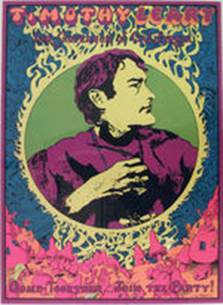
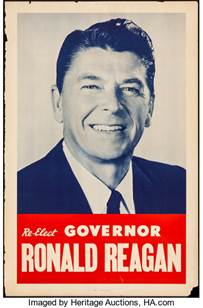
Timothy Leary and John Lennon: In May and June of 1969, John Lennon and Yoko Ono were holding a “Bed-In” at the Queen Elizabeth Hotel in Montreal. They had planned on being in New York, but had been refused entry to the U.S. because of a prior conviction for marijuana possession. Among their many visitors in Room 1742 were Leary and his wife Rosemary who are shown below as part of the chorus when “Give Peace a Chance” was being recorded in the hotel room. The other guitar player is Tommy Smothers.
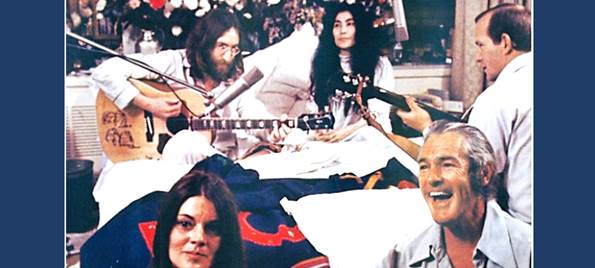
Leary asked Lennon to write a campaign song based on his “Come Together” slogan. Lennon did so, but it was for naught. Leary’s campaign ended when he was imprisoned for marijuana possession in early 1970.
[Hotel Trivia: In 2013, Rita and I, along with Woody and Jane Overton, vacationed in Montreal and stayed at the (Fairmount) Queen Elizabeth Hotel. Rita talked an assistant manager into letting her see Room 1742 and its “Bed-In” memorabilia. The room is available for booking.]
John Lennon and Chuck Berry: John Lennon liked the “Come Together” hook and moved from his Leary campaign song to something more rock ‘n’ roll. His inspiration was Chuck Berry’s 1956 record “You Can’t Catch Me.” He even borrowed a line from Chuck (“Here come a flat-top / He was movin’ up with me.”). The first two lines of Lennon’s song: “Here come old flat-top / He come groovin’ up slowly.”
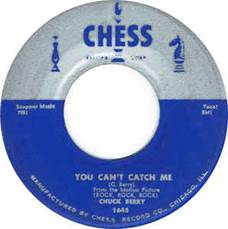
It is no surprise that John would be inspired by Chuck. All of the Beatles had grown up on U.S. rock ‘n’ roll and covered the likes of Little Richard and Chuck Berry in the early days. John famously said, “If you had to give rock ‘n’ roll another name, it might be Chuck Berry.”
John Lennon and Paul McCartney: In July and August of 1969, the Beatles gathered at the Abbey Road studio to work on what would turn out to be their last recording sessions together. John offered up his working version of “Come Together,” and Paul McCartney quickly noticed that John had borrowed liberally from Chuck Berry’s song. So Paul thought they should “spin it” by slowing it “down with a swampy bass-and-drum vibe.” They kept the “flat-top” lines from Chuck’s lyrics, but felt they ended up with an original song. “Come Together” became the first cut on the Abbey Road album and was also released as a single, going to #1 as a two-sided hit with “Something” on the flip side.
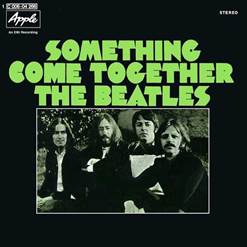
When Timothy Leary heard about the hit, he made what he called a “mild protest” to John for taking his idea. Leary said John “replied with typical Lennon charm and wit that he was a tailor and I was a customer who had ordered a suit and never returned. So he sold it to someone else.”
John Lennon and Morris Levy: The “flat-top” line came to the attention of Morris Levy, the owner of the publishing rights for Chuck Berry’s “You Can’t Catch Me.” Levy made a claim of plagiarism, but Lennon strongly disagreed, insisting that the song was “independent of Chuck Berry or anybody else on earth.” In a settlement, Lennon kept the rights to the song, but agreed to use some of Levy’s catalog when he did a rock ‘n’ roll oldies solo album he was planning.
Now, for your listening pleasure, here are both John and Chuck (sounding nothing alike). Don’t miss Chuck’s duck-walking at the end of his video.
“Come Together” and “You Can’t Catch Me”
[Copyright Infringement Trivia: Chuck Berry claimed that the Beach Boys hit “Surfin’ USA” was a virtual copy of his “Sweet Little Sixteen.” Brian Wilson denied any intentional wrongdoing, but admitted he took Chuck’s song and rewrote it with a surfing style. The band’s manager, Brian’s father Murray, did not want any litigation and signed the writing credit over to Chuck. When George Harrison went solo after his Beatles days, he had a #1 hit with “My Sweet Lord.” But a judge ruled that George had unconsciously copied “He’s So Fine,” a hit for the Chiffons in 1963. If you want to compare, click on the song titles to listen.]
The album cover for Abbey Road became a classic. Left to right: George (photobombed by the nearby VW “Beetle”), Paul (barefoot), Ringo (in black) and John (in white).
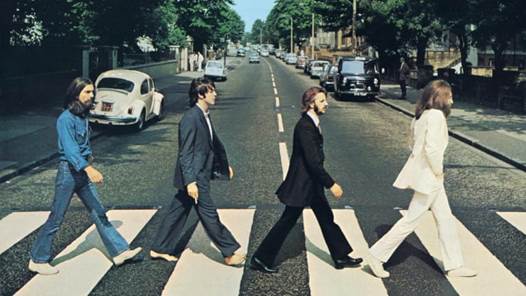
Lonnie’s Jukebox – Abbey Road – 2020: MLB is promoting next year’s Cubs-Cardinals series in London with a photo of Kris Bryant, Anthony Rizzo, Paul Goldschmidt and Yadier Molina crossing Abbey Road. Rizzo is barefoot in the photo, as Paul McCartney was on the album cover. The original photo led to false rumors that McCartney was dead, and walking barefoot was allegedly one of the clues. McCartney and Rizzo are alive and well.
